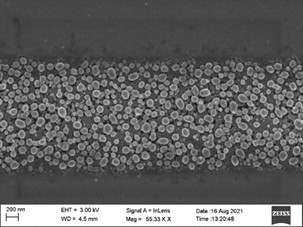Indium Tin Oxide: A Superconducting Material Enabling Quantum Readouts
Outcome/Accomplishment
Researchers developed superconductors that, with an ultra-low thermal footprint, were able to read the data carried in qubits, the data packets of quantum networking. The experiments were conducted at the Center for Quantum Networks (CQN), an NSF-funded Engineering Research Center (ERC) based at the University of Arizona.
Impact/Benefits
The researchers have shown that the integration of superconducting electronics and quantum photonics can achieve efficient transduction and readout of qubits. That's a key step toward readouts that are fast, accurate, and performed using hardware that facilitates high qubit connectivity.
Explanation/Background
The material used by the CQN researchers, indium tin oxide (ITO), is a transparent semiconductor that can behave as a superconductor. Prior work has shown that commercially available ITO can be electrochemically reduced, permitting superconductivity.
CQN is a full-stack quantum networking program that brings together experts with diverse backgrounds to develop theoretical research and critical components in the entire stack of device and subsystem technologies to realize the vision of a scalable quantum Internet. CQN's research focus is on building a quantum communication infrastructure supported by fault-tolerant quantum repeaters and routers.
Location
Tucson, Arizonawebsite
Start Year
Microelectronics and IT
Microelectronics, Sensing, and IT
Lead Institution
Core Partners
Fact Sheet
Outcome/Accomplishment
Researchers developed superconductors that, with an ultra-low thermal footprint, were able to read the data carried in qubits, the data packets of quantum networking. The experiments were conducted at the Center for Quantum Networks (CQN), an NSF-funded Engineering Research Center (ERC) based at the University of Arizona.
Location
Tucson, Arizonawebsite
Start Year
Microelectronics and IT
Microelectronics, Sensing, and IT
Lead Institution
Core Partners
Fact Sheet
Impact/benefits
The researchers have shown that the integration of superconducting electronics and quantum photonics can achieve efficient transduction and readout of qubits. That's a key step toward readouts that are fast, accurate, and performed using hardware that facilitates high qubit connectivity.
Explanation/Background
The material used by the CQN researchers, indium tin oxide (ITO), is a transparent semiconductor that can behave as a superconductor. Prior work has shown that commercially available ITO can be electrochemically reduced, permitting superconductivity.
CQN is a full-stack quantum networking program that brings together experts with diverse backgrounds to develop theoretical research and critical components in the entire stack of device and subsystem technologies to realize the vision of a scalable quantum Internet. CQN's research focus is on building a quantum communication infrastructure supported by fault-tolerant quantum repeaters and routers.

